People and Goods on the Move: Indiana’s Transportation and Warehousing Sector
One area of Indiana’s economy that could use more attention from analysts is transportation and warehousing. After all, Indiana is “The Crossroads of America” (the state motto adopted in 1937). Is it merely our geographic location that warrants such a title? That may have been true from the perspective of North America’s early explorers and merchants, but there obviously have been many developments in infrastructure and technology since then. Is Indiana worthy of holding that title? Let’s see if we can uncover some evidence in the available workforce data.
While reviewing the figures, it would be helpful to keep in mind that the demand for transportation and warehousing is a derived demand. For example, the demand for warehousing services is derived from the demand for the goods that are being distributed. This way of thinking applies to passenger transportation as well. For example, the demand for an airplane ticket might be derived from the demand to attend a far-away business conference, or alternatively, to go on a vacation in the Bahamas. This may seem obvious, but is worth mentioning before continuing.
How Are We Doing?
Table 1 summarizes how Indiana has fared in transportation and warehousing employment and wages from the first quarter of 2001 to the third quarter of 2003 (the most recent quarter available). It is not surprising that jobs in this area have declined, given the corresponding declines in other areas of the economy.
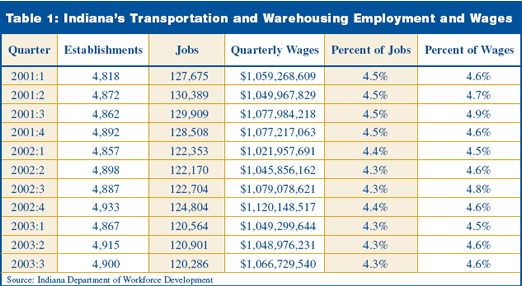
In fact, if we analyze the relationship between employment in this sector and the manufacturing sector, we find a correlation coefficient of +0.85 (a value of +1 would indicate a perfect positive relationship). This means that employment in the two sectors tends to change in the same direction; so when manufacturing jobs decline, as has been the case recently, transportation and warehousing jobs tend to decline as well. The relationship between jobs in the transportation and warehousing sector and jobs in the retail trade sector is even stronger, yielding a correlation of +0.88. Other sectors that have a high correlation with the transportation and warehousing sector include wholesale trade and information, both at +0.9. The result for wholesale trade is not too surprising, since goods that are bought and sold need to be transported. The information sector may seem out of place here, unless you consider that 31.1 percent of those jobs are in telecommunications and another 5.4 percent are with Internet service providers, Web search portals and data processing services. Those areas have become more closely related to transportation and warehousing as the logistics profession becomes more sophisticated. Moreover, 38.3 percent of information sector jobs are attributed to publishing, motion picture and sound recording industries, which depend on transportation and warehousing workers to distribute hard copies of their works.
Although employment in the transportation and warehousing area has declined, it is notable that the average weekly wage has exhibited a generally increasing trend (see Figure 1). If we compare the third quarter of 2003 to the same quarter of 2001 (the end of the 2001 recession), the five industries in question show the following increases:
- Transportation and warehousing: 6.9 percent
- Manufacturing: 6.9 percent
- Retail trade: 5.8 percent
- Wholesale trade: 7.7 percent
- Information: 7.8 percent
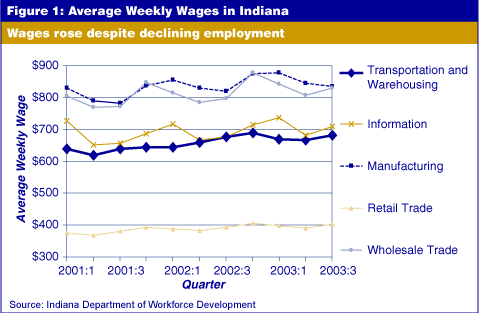
According to the change in the average annual Consumer Price Index (CPI) between 2001 and 2003 (released by the U.S. Bureau of Labor Statistics), these increases outpace the inflation we experienced, which was 3.9 percent over the two-year period. The gains are even greater if we compare them to the change in the CPI for the Midwest, which was only 3.2 percent. Why did average wages go up while jobs went down? Perhaps this in part reflects layoffs of the newest employees, who tend to have below average earnings. Also, the remaining employees may work more hours, adding overtime pay to the average.
Where Are the Transportation and Warehousing Jobs?
One way to determine the location of jobs is to look at employment by county. As expected, Marion County holds the lion’s share of these jobs, far surpassing all other counties with 37,276 jobs in 2003:3, or 6.5 percent of total employment in the county. Coming in second is Allen County at 8,244 (4.7 percent). Lake County is third with 7,244 jobs (3.8 percent) and fourth is Vanderburgh County with 5,153 jobs (4.8 percent). This author wonders whether Vanderburgh County will rank higher in future decades, given the eventual construction of the I-69 extension in the next 10 to 15 years.
To examine the concentration of these jobs, let’s focus on the percentage of total covered employment (see Figure 2). Wells County tops this list at 15.5 percent, well above the state average of 4.3 percent. Jackson County is next at 12.7 percent. Other counties with relatively high concentrations include Martin County (11.3 percent), Clark County (11.1 percent), Hendricks County (9.4 percent) and Crawford County (8.3 percent). Interestingly, Hamilton County ranks last at 1.1 percent.
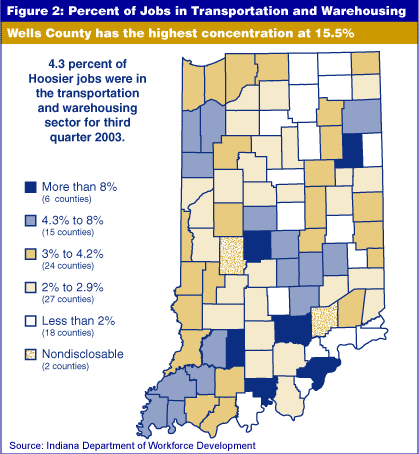
Nearly one-sixth of Wells County’s wages and jobs come from transportation and warehousing (see Table 2). Notably, the transportation and warehousing sector in Jackson, Clark, Crawford and Hendricks counties pays well above the overall average weekly wage for the county. In Martin County, pay within the sector is comparable to that of other counties; but the overall average weekly wage is $934, boosted by the presence of Crane Naval Surface Warfare Center.
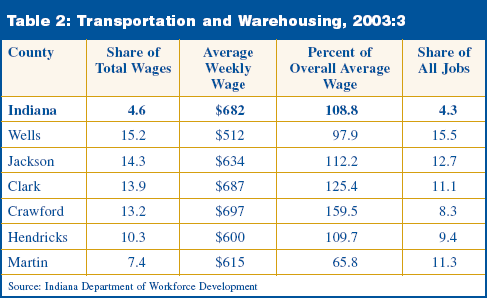
Another way to look at the distribution of jobs is by industry classification. The transportation and warehousing sector has 11 subsectors (see Table 3). Here we have uncovered some limitations in the data: Two subsectors do not have data available due to nondisclosure requirements (too few establishments or one dominant establishment in the subsector). Also, data for the rail transportation subsector are not available because those workers are not part of covered employment (since they have their own unemployment insurance system). Nonetheless, it is clear that the truck transportation subsector dominates Indiana’s employment in this sector, with 47,869 jobs in the third quarter of 2003. Ranking a distant second is the warehousing and storage subsector at 18,681 jobs.
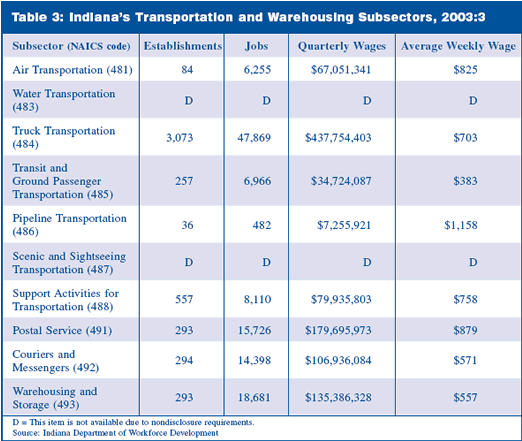
Keeping Up with the Joneses
How do we measure up in transportation and warehousing employment compared to neighboring states? You might be surprised to see how we rank (see Table 4). According to 2003 average annual employment for Indiana and five surrounding states, we rank third out of six. Of course, this measure is influenced by the size of each state’s population; thus, a per capita employment measure would level the playing field. To get these figures, we divided the average annual employment in the sector by the Census Bureau’s population estimate for 2003. The interpretation of those minuscule numbers in Table 4 can be simplified if you think in terms of jobs per 10,000. For example, for every 10,000 Hoosiers, about 172 work in the transportation and warehousing sector. By this measure, we rank fourth out of six, although we are nearly equal to third-place Wisconsin. If we instead look at the share of total nonfarm employment, Indiana overtakes Wisconsin by 0.3 percentage points.
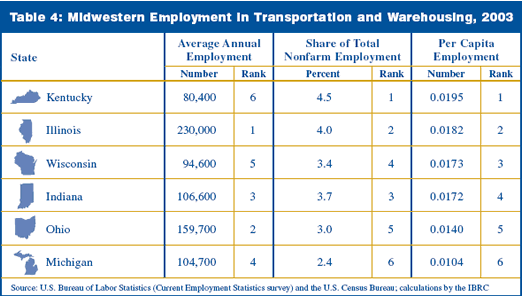
What can we make of these ranks? While Indiana has a natural geographic advantage, it seems we are not making full use of it. Many have cited our inventory tax as the culprit for missed opportunities. Now that it is on the way out (and is already gone for some counties), perhaps we will gain some ground. Although not unanimously popular, the upcoming extension of I-69 also promises many opportunities for Indiana’s transportation and warehousing firms. Lastly, a lot of folks think it would help to adopt daylight-saving time, the majority favoring central over eastern. Real costs result from our state’s current individualism, especially for the firms under consideration here. Should we spring forward and fall back like everyone else? The logistics professionals who are spearheading the 21st Century Logistics initiative in our state seem to believe so.
| Indiana
Logistics Initiative (21st Century Logistics)
Indiana Logistics Summit |
Vincent Thompson
Economic Analyst, Indiana Business Research Center,
Kelley School of Business, Indiana University
